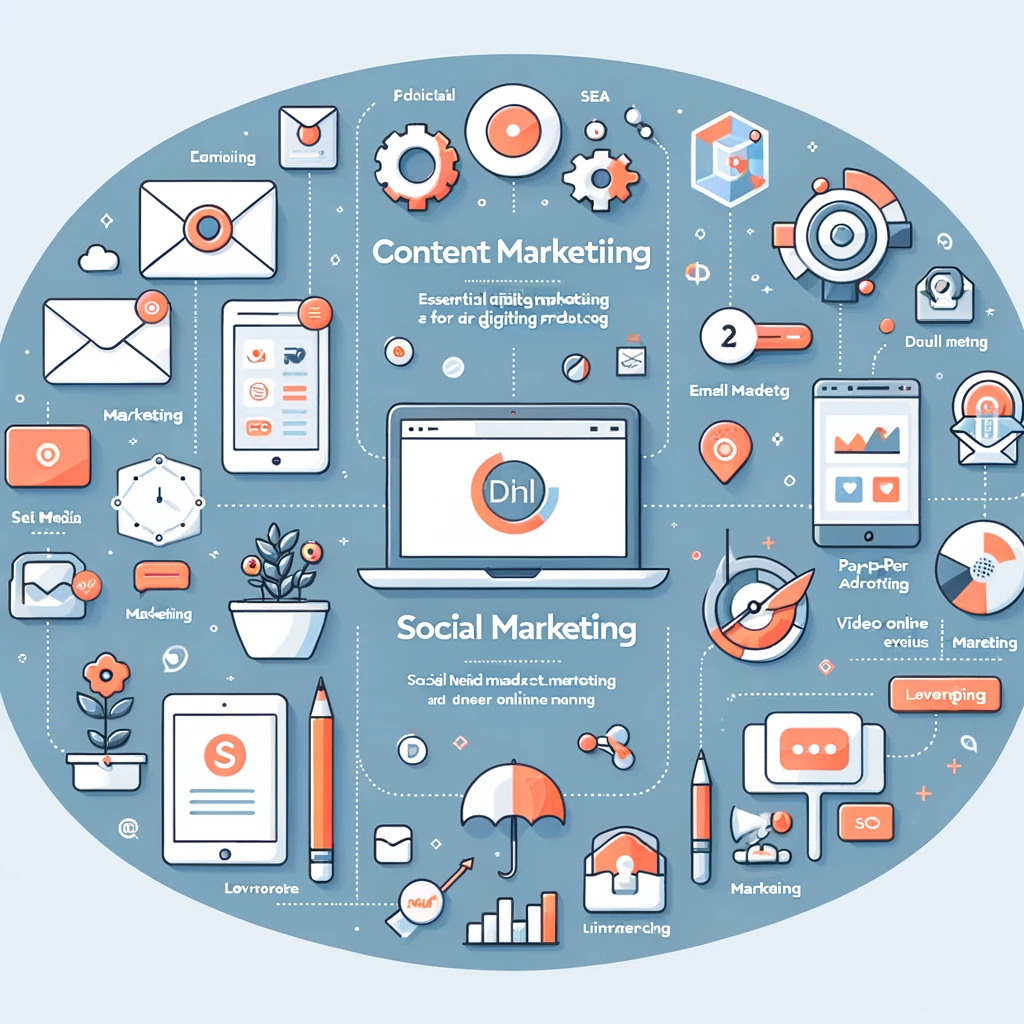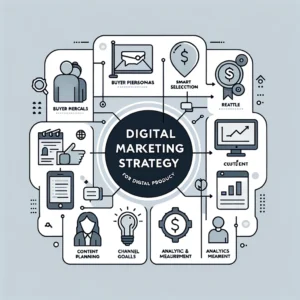The right marketing strategy can elevate your product from being just another option to the preferred choice for your target audience. The advent of the internet and digital technologies has revolutionized how businesses reach out to potential customers. Making the competition fiercer than ever. In such a crowded marketplace, understanding how to effectively market your digital products is not just an advantage; it’s a necessity.
Digital products, ranging from:
- software,
- ebooks,
- online courses,
- to various subscriptions,
require a nuanced approach to marketing.
Unlike physical goods, digital products are intangible. Making their value and utility less immediately apparent. Therefore, a robust marketing strategy for digital products should not only aim to reach a wide audience but also engage them in a manner that clearly communicates the unique benefits and solves the pain points of the potential customers.
The core of any successful digital product marketing strategy lies in understanding your audience deeply.
Setting clear and achievable goals, and leveraging the right mix of digital channels to communicate your message. With technologies evolving rapidly, staying updated with the latest digital marketing trends is crucial. Yet, the foundational elements remain consistent: know your market, understand the customer journey, and deliver value at every touchpoint.
This guide aims to demystify the process of creating a compelling marketing strategy for your digital products. From building detailed buyer personas to selecting the right digital marketing channels and measuring the effectiveness of your strategies, we’ll cover the essentials that every digital marketer needs to know. Let’s dive into the world of digital product marketing, where creativity meets strategy, and discover how to turn your digital products into a thriving online business.
Next, we’ll explore the intricacies of understanding digital marketing strategies, laying the groundwork for developing a marketing plan that not only reaches but resonates with your target audience.
Understanding Digital Marketing Strategies
In the digital era, a well-crafted digital marketing strategy is pivotal for the success of any digital product. This strategy is essentially your game plan for reaching and engaging your target audience online. It outlines how you’ll use various digital channels and tools to communicate your product’s value proposition and convert prospects into loyal customers.
What is a Digital Marketing Strategy?
At its heart, a digital marketing strategy is a comprehensive plan that guides all your online marketing efforts. Unlike isolated marketing campaigns that might focus on a specific goal or channel, a digital marketing strategy provides a broad vision for achieving your business objectives through digital means. It integrates all aspects of online marketing—social media, content marketing, SEO, email marketing, and paid advertising—into a cohesive, strategic framework.
Why is it Important for Digital Products?
Digital products thrive on online visibility and engagement. With no physical presence, your digital product’s marketability hinges on your ability to effectively use digital channels to highlight its features, benefits, and value to potential users. A strategic approach to digital marketing enables you to:
- Build Awareness: Introduce your digital product to a wider audience.
- Engage Prospects: Provide valuable information that addresses the needs and interests of your target market.
- Drive Conversions: Use targeted campaigns to convert interested prospects into paying customers.
- Foster Loyalty: Maintain an ongoing relationship with customers, encouraging repeat business and referrals.
Key Elements of a Digital Marketing Strategy

- Buyer Personas: Detailed profiles of your ideal customers help tailor your marketing efforts to meet the specific needs, behaviors, and concerns of your target audience.
- SMART Goals: Specific, Measurable, Achievable, Relevant, and Time-bound objectives that align with your overall business goals.
- Channel Selection: Identifying the most effective digital channels (social media, email, SEO, etc.) to reach and engage your audience.
- Content Planning: Developing a content strategy that supports your marketing objectives, including types of content, topics, and publishing schedules.
- Analytics and Measurement: Tools and metrics to track the performance of your digital marketing efforts, enabling ongoing optimization.
By understanding the fundamentals of digital marketing strategies, businesses can better navigate the digital landscape, effectively promoting their digital products. In the next section, we’ll delve into the key components of a digital marketing strategy, providing a roadmap for building a strong online presence and driving growth for your digital product offerings.
Key Components of a Digital Marketing Strategy
Creating a successful digital marketing strategy for your digital products involves several key components. Each element plays a crucial role in how effectively you connect with your audience and achieve your marketing goals. Let’s dive deeper into these components to understand how they come together to form a comprehensive digital marketing plan.
1. Building Buyer Personas
The foundation of any effective marketing strategy is a deep understanding of your target audience. Buyer personas are fictional, generalized representations of your ideal customers. They help you to understand your customers (and prospective customers) better, making it easier to tailor your content, messaging, product development, and services to meet the specific needs, behaviors, and concerns of different groups.
How to Create Buyer Personas?
- Conduct market research and gather data from your existing customer base.
- Identify customer goals, pain points, preferences, and demographic details.
- Analyze interactions with your business to understand buying behavior and decision-making processes.
Creating detailed buyer personas allows you to segment your audience and target your marketing messages effectively, resulting in higher engagement and conversion rates.
2. Setting Goals and Objectives
Without clear goals, it’s difficult to measure success or know where to allocate your marketing efforts. Setting SMART goals ensures that your digital marketing strategy is guided by specific, measurable, achievable, relevant, and time-bound objectives.
Examples of SMART Goals for Digital Marketing:
- Increase website traffic by 25% within the next six months.
- Boost conversion rates on landing pages by 15% by the end of the quarter.
- Grow email subscriber list by 20% within four months.
These goals give direction to your digital marketing strategy and provide benchmarks to measure your progress.
3. Channel Selection
Not all digital marketing channels will be suitable or effective for your digital product. Choosing the right channels is about understanding where your target audience spends their time online and how they prefer to consume content.
Popular Digital Marketing Channels:
- Social Media: Great for building brand awareness and engaging with your audience.
- Email Marketing: Effective for nurturing leads and keeping your audience informed.
- Content Marketing: Helps to establish authority and provide value to your audience.
- Search Engine Optimization (SEO): Increases visibility in search engine results, driving organic traffic.
- Pay-Per-Click (PPC) Advertising: Offers a quick way to increase visibility and drive targeted traffic.
Each channel has its strengths and can be used in different stages of the customer journey.
4. Content Planning
Content is the backbone of digital marketing. Your content strategy should align with your overall marketing goals and speak directly to your buyer personas.
Key Considerations for Content Planning:
Effective content planning ensures that you are consistently providing valuable information that attracts, engages, and converts your target audience.
- Type of Content: Blog posts, videos, infographics, eBooks, and social media posts.
- Content Topics: Should be relevant to your audience’s interests and challenges.
- Publishing Schedule: Consistency is key to keeping your audience engaged.
5. Analytics and Measurement
To improve your digital marketing strategy over time, it’s essential to measure the performance of your campaigns and initiatives. Using analytics tools, you can track a wide range of metrics to understand what’s working and what isn’t.
Important Metrics to Track:
- Traffic Sources: Understand where your visitors are coming from.
- Engagement Rates: Measure how audiences interact with your content.
- Conversion Rates: Track how many visitors are taking the desired action.
- ROI: Calculate the return on investment for different marketing activities.
By analyzing these metrics, you can make data-driven decisions to optimize your digital marketing strategy and achieve better results.
In the next section, we will explore essential digital marketing strategies for digital products, focusing on how to implement these key components to drive growth and success in the digital marketplace.
Essential Digital Marketing Strategies for Digital Products
To effectively market digital products, it’s important to leverage a combination of strategies tailored to meet your goals and resonate with your target audience. Here are some essential digital marketing strategies that can help elevate your digital product’s presence online and drive meaningful engagement and conversions.
Content Marketing and SEO
Content marketing and Search Engine Optimization (SEO) are closely intertwined strategies that focus on creating and distributing valuable, relevant, and consistent content to attract and retain a clearly defined audience — ultimately, to drive profitable customer action. By providing content that addresses the needs and interests of your audience, you can establish your brand as a thought leader and authority in your niche.
Key Aspects:
- Blog Posts and Articles: Share insights, tutorials, and relevant information that adds value to your audience.
- SEO Best Practices: Optimize your content with targeted keywords, quality backlinks, and a user-friendly website structure to improve visibility in search engine results.
Social Media Marketing
Social media platforms offer a dynamic environment to engage with your audience, build brand awareness, and promote your digital products. The key is to choose platforms where your target audience is most active and to create content that encourages interaction.
Effective Tactics:
- Regular Posting: Maintain an active presence with regular updates and posts.
- Engagement: Respond to comments, participate in conversations, and encourage user-generated content to foster community.
- Promotions and Ads: Utilize paid advertising options to reach a broader audience and drive targeted traffic to your website or product pages.
Email Marketing
Email marketing remains one of the most effective digital marketing strategies for maintaining direct communication with your audience. It allows you to personalize your messaging, segment your audience, and deliver targeted content that leads to higher engagement rates and conversions.
Strategies Include:
- Newsletters: Keep your audience informed about new content, product updates, or exclusive offers.
- Drip Campaigns: Automate a series of emails that guide leads through the buying process.
Pay-Per-Click Advertising (PPC)
PPC advertising can quickly increase visibility and drive targeted traffic to your digital product pages. By bidding on keywords relevant to your products, you can display ads in search engine results and on partner websites, paying only when a user clicks on your ad.
Benefits:
- Targeted Reach: Target specific demographics, locations, and interests to reach your ideal customers.
- Measurable Results: Track the effectiveness of your ads in real-time and adjust your strategy accordingly.
Video Marketing
Videos are a powerful tool to engage your audience and provide a visual demonstration of your digital products. They can improve SEO, increase brand awareness, and boost conversion rates.
Implementation Tips:
- Product Demos: Show your product in action to highlight its features and benefits.
- Customer Testimonials: Share success stories and reviews from satisfied customers to build trust.
Leveraging Online Events
Hosting online events, webinars, or product launches can create buzz around your digital product. These events offer a platform to engage directly with your audience, provide in-depth product demonstrations, and answer questions in real-time.
Key to Success:
- Promotion: Use your digital channels to promote the event and encourage registrations.
- Value: Ensure your event delivers valuable information or entertainment to encourage attendance and engagement.
Each of these strategies plays a vital role in a comprehensive digital marketing plan for digital products. By understanding your audience, setting clear objectives, and utilizing a mix of these strategies, you can create a strong online presence for your digital products, driving both engagement and sales.
Implementing and Measuring Your Digital Marketing Strategy
The final step in creating a successful digital marketing strategy for digital products involves implementation and continuous measurement. This phase ensures that your strategy is not only put into action but also optimized based on performance data. Let’s explore how to implement your strategy effectively and measure its impact.
Implementing Your Strategy
- Action Plan: Develop a detailed action plan that outlines specific tasks, responsible team members, deadlines, and resources required for each component of your strategy. This plan should be aligned with your overall marketing goals and buyer personas.
- Integration: Ensure that all elements of your digital marketing strategy work together cohesively. For example, your content marketing efforts should support your SEO goals, and your email marketing campaigns should drive traffic to your latest content or product pages.
- Technology and Tools: Utilize the right technology and tools to streamline your marketing efforts. This might include content management systems, email marketing platforms, social media management tools, and analytics software.
- Team Collaboration: Encourage collaboration among team members responsible for different aspects of your digital marketing strategy. Regular meetings and updates can help ensure that everyone is aligned and working towards the same objectives.
Measuring Your Strategy
- Set Key Performance Indicators (KPIs): Identify the KPIs that will help you measure the success of your strategy. These might include website traffic, conversion rates, engagement metrics on social media, email open rates, and more.
- Use Analytics Tools: Leverage analytics tools to track and measure your KPIs. Google Analytics is a powerful tool for monitoring website traffic and user behavior, while social media platforms and email marketing services offer their own analytics for tracking performance.
- Regular Reviews: Conduct regular reviews of your digital marketing performance. Analyze what’s working and what isn’t, and use these insights to make informed decisions about how to adjust your strategy for better results.
- Adapt and Optimize: Digital marketing is dynamic, and what works today may not work tomorrow. Be prepared to adapt your strategy based on changing market conditions, new trends, and the evolving needs of your target audience.
Implementing a digital marketing strategy for digital products requires careful planning, execution, and ongoing optimization. By effectively implementing your strategy and rigorously measuring its performance, you can ensure that your digital products reach the right audience, engage them meaningfully, and drive conversions. Continuous learning and adaptation are key to sustaining success in the ever-changing digital landscape.
Staying Agile and Ahead in Digital Marketing
Digital marketing is an ever-evolving field, with new trends, technologies, and consumer behaviors emerging regularly. Staying agile and flexible in your digital marketing strategy is not just beneficial; it’s essential for staying competitive and achieving long-term success.
Embracing New Technologies and Platforms
- Keep an Eye on Emerging Trends: Technologies like artificial intelligence, augmented reality, and blockchain are beginning to influence digital marketing. Stay informed about these trends and consider how they might be integrated into your strategy.
- Experiment with New Platforms: As new social media platforms and digital channels emerge, be open to testing them out. Early adoption can give you a competitive edge and open up new avenues for engagement.
Fostering a Culture of Continuous Learning
- Educate Your Team: Invest in training and development for your team. Encouraging continuous learning ensures that your team remains skilled in the latest digital marketing strategies and tools.
- Learn from Industry Leaders: Follow digital marketing thought leaders, subscribe to industry newsletters, and attend webinars and conferences to gain insights and inspiration.
Using Data to Drive Decisions
- Leverage Analytics: Use data analytics to guide your marketing decisions. Analyzing customer data can reveal patterns and preferences that inform more targeted and effective marketing strategies.
- Conduct A/B Testing: Regularly test different aspects of your digital marketing campaigns, from email subject lines to landing page designs, to understand what works best for your audience.
Building Flexibility into Your Strategy
- Review and Revise Regularly: Make it a habit to review your strategy regularly and be prepared to make adjustments in response to performance data and market changes.
- Encourage Feedback: Listen to feedback from your customers and team. Customer feedback can provide valuable insights into how your marketing strategy and digital products can be improved.
Conclusion
Creating a digital marketing strategy for digital products involves understanding your audience, setting clear goals, choosing the right channels, creating compelling content, and leveraging technology. However, the work doesn’t stop once the strategy is implemented. Continuous measurement, optimization, and agility are key to sustaining success. By staying informed, embracing innovation, and focusing on data-driven decisions, you can navigate the complexities of digital marketing and drive lasting growth for your digital products.
Remember, the digital landscape is always changing, and so should your approach to marketing within it. The ability to adapt and evolve your strategy will not only keep you ahead of the curve but also ensure that your digital products continue to thrive in an increasingly competitive marketplace.




